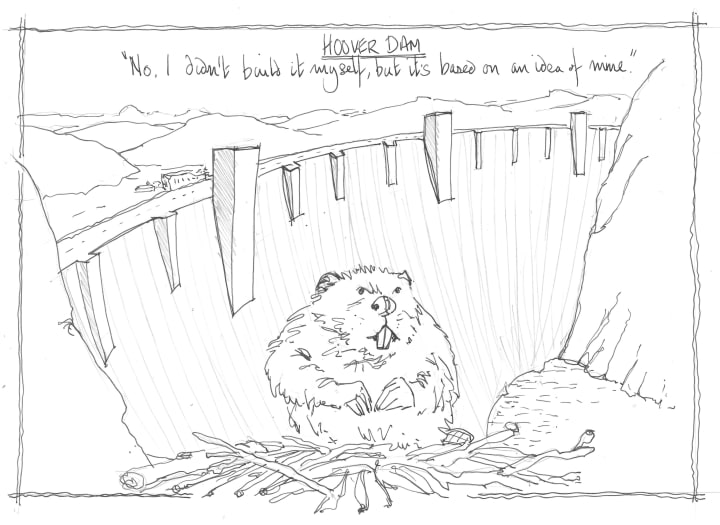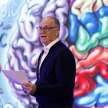Evolution not Revolution.
How Innovation Happens.

The difference between innovation and invention.
Fritz Haber, the German chemist, was awarded the Nobel prize in 1918 for what is now known as the Haber-Bosch Process. Haber invented a method of fixing nitrogen from the air by using a catalyst and pressure. This method then enabled the synthesis of ammonia from nitrogen and hydrogen gas.
Nitrogen used in fertilizers from the Haber-Bosch process has been estimated as assisting two-thirds of the global annual food production, which supports nearly half the world's population. Thereby saving countless lives. However, the process also enabled the easy production of explosives, thereby taking countless lives.
However, the point here is that although Fritz Haber invented the method and was awarded the Nobel Prize, it was successful due to the efforts of Carl Bosch. Bisch experimented for years, overcame many problems and found ways to use ideas from other industries that lead to large-scale production and reduced costs.

Invention is the generation of an idea, either by synthesis and recombination or by development. Innovation is taking that idea and bringing it to the "market" in a way that adds benefit or value. Innovators have the grit to simplify or drive down costs so that the invention can benefit and make a difference to the most significant number of people.
"The capitalist achievement does not typically consist of providing more silk stockings for queens but in bringing them within reach of factory girls in return for steadily decreasing amounts of effort."
Joseph Schumpeter 1942
For innovations to be successful, they must solve a problem, deliver benefits and value at the least amount of effort, and become affordable (this will become inversely proportional to the desire/need for the product and the problem it solves).
An invention is a necessary part of the innovation process, but it is not sufficient; other elements must combine to bring about innovation.
THE DRIP, DRIP OF INNOVATION PROGRESS
There are many ways to tell a story about innovation; most of them will include a hero who has an epiphany, a Eureka moment in which they have a flash of inspiration, a bolt from the blue. Unfortunately, the media prefer to propagate this myth. Who doesn't love a good story?
However, if you look a little more closely, you will mostly see that innovation results from a great deal of hard work and determination. Reality is somewhat different. It would be very rare to discover or invent something if the right conditions weren't available or nearly available at that time. Often, innovators are already looking in the direction, and their gaze is fixed on the prize.

One thing leads to another. Would we have computers If we didn't have the jacquard loom, punched cards with multiple rows of holes that set out weaving patterns? If we didn't have Babbage's calculating machines. Would Alan Turing have been able to develop the Turing machine, the model of the general-purpose computer, if he hadn't been aware of Babbage and Jacquard algorithms, probably not? Would we have the mobile phone, a hand-held computer, it hadn't had Turing and Alexander Graham Bell? Possibly, but unlikely. One thing leads to another and is driven by desire, benefit or value.
The myth of the inventor finding their Ah-ha moment better serves our need for a story. However, the reality is somewhat different. It's an evolutionary process. A slow drip feed where one thing leads to another.
This helps us understand why so often two, or more, people seem to come up with the same or similar ideas simultaneously. As with the invention of Calculus, both Newton and Leibniz developed the mathematical system simultaneously. They accused each other of plagiarism. But it is now acknowledged that the circumstances were ripe for bearing the mathematical fruit. As Isaac Newton famously said: "I stand on the shoulders of giants". He, too, was aware that he owed a debt to those who had gone before him. (In my article "Zero-sum game" I mentioned the "invention of the concept of Zero and "Arabic numbers" which were attributed to Fibonacci, yet the lineage of modern numbers can be traced back centuries before Fibonacci)
The fact that we have patent laws continues to propagate the myth of the Eureka moment. Of course, ownership of a patent protects and safeguards the inventor's interest and future profit. But, at the same time, it reinforces the idea that inventions have been created ex-nihilo, out of nothing, and have no debt to those who have knowingly, or unknowingly, contributed to the product's development.
Take, for instance, the design of the violin. It has changed over time in a gradual process of evolution. Initially, the hole to allow sound to resonate and escape was round. It then became semi-circular, elongated, and gradually developed into the f-shaped hole we know as the violin. Finally, incremental changes have been optimized in history (not to say anything about electric violins).
All technologies and ideas have their origins in something that has gone before them. Inventors and innovators build on previous knowledge, technology and experience and step one step further in a continuous process that, like evolution, develops by happenstance driven by desire, benefit and value.

THE ADJACENT POSSIBLE
If you can imagine a bubble representing all knowledge, then the skin of that bubble is called the adjacent possible. This is where a creative mind will step beyond, but not too far beyond, to create something that seems to be novel or new. The surface of the knowledge bubble represents current knowledge and, to some extent, safety. We know what we know. Outside of this surface is risk and danger, which we don't know yet. Too far distant from the skin and the novel ideas have no reference points and therefore no value. On the other hand, adjacent to the skin, new ideas have relevance.
Like inventors and innovators, creative minds will have the courage and the grit to take the risk and step into uncertainty. They use what is known as synthesis, recombination, or adaptation to create something emergent and unknown.
We've often heard someone say that an invention was ahead of its time. This could be true when something is a little too far beyond the adjacent possible, but it becomes relevant in the future (think Star Trek communicators and mobile phones). The bubble (and the available technologies) has expanded to meet the idea, which has value for the users who previously saw no value.
Many different technologies and concepts must be evident for the innovator to bring together a new form to develop an automobile. Refined crude oil, controlled explosions, the wheel, differentials, the horse cart, the internal combustion engine, and many more. Modern mobile phones are only possible if the battery technology is nascent; if computer chips can be small enough, a liquid crystal display that generates colours, a set of wires that detect where you touch the screen, and a protective glass cover toughened. Many different things must be available and adaptable for innovation to happen.

SERENDIPITY
In 1754 Horace Walpole coined the phrase "Serendipity". He was referring to moments of good fortune that happen by chance. Based on the Persian fairy tale, "The Three Princes of Serendip", in which the princes were "always making discoveries, by accident and sagacity, of things they were not in quest of".
Accidental discoveries are a common myth when we discuss innovation. Yet, we don't usually find things by chance unless we are already in a mindset that is open to such things and/or already looking in that direction.
There are many famous examples: Roy Plunkett invented Teflon whilst trying to develop refrigerant fluids. A chemical had polymerized and turned solid whilst storing tetrafluoroethylene gas at sub-zero temperatures. The white powder was found to be PTFE, which had no use as a refrigerant but was heat resistant, inert, and almost entirely frictionless. This is now ubiquitous in non-stick frying pans, Goretex and, of course, on Apollo missions to the moon.
Similarly, Kevlar was discovered by Stephanie Kwolek at Dupont.
"Some inventions result from unexpected events and the ability to recognize these and use them to advantage."
Stephanie Kwolek
The creative mind is alert to chance, luck and serendipity.
WHEN IDEAS HAVE SEX. ASSOCIATION, AND RECOMBINATION.
Every advance is the result of advances that have been previously made and are reformed in a new way to create something emergent. As Matt Ridley says, "Innovation happens when ideas have sex".
Nothing comes from nothing. As mentioned above, ideas, concepts, and technologies need to be recombined into new forms with value. This also explains why similar ideas often happen at the same time in different places.
This is perhaps why networks and teamwork are so important in encouraging innovation. Where ideas are freely (sometimes not so freely) exchanged, there emerges a mushrooming of advances. More about that later.
It shouldn't surprise any of us that Association and recombination are among the most potent ways innovation happens. It's how our brains work for the most part. Almost all memory is hinged on previous associations. Likewise, most language is based on familiar concepts expressed in metaphorical language. Metaphors are the explanation of one thing in terms of another.
In his book "Moonwalking with Einstein", Joshua Foer outlines the techniques used by the world memory champions, which are all based on associative hooks. Like the "Method of Loci" demonstrated by Ciceros' Memory Palace. We remember and recall based on the associations and patterns we create when we see something.
It has long been shown that creative minds are better at Association and recombination of disparate ideas. E=MC2 is a new association of energy with matter and light. Printing was the Association of a wine press and writing that brought the power of words to the masses.
Innovation happens when the circumstances are ripe, and there is a mind to associate and recombine ideas from diverse locations. That, of course, doesn't mean that no effort is required in bringing an invention to those who may value it.

MORE ERROR THAN TRIAL.
It takes effort and determination, trial and error, failure and some success to bring an idea to full fruition.
"The most important of my discoveries have been suggested to me by my failures".
Humphrey Davy
There are endless examples of triumph after failure. From Thomas Edison, James Dyson, Henry Booth, Marconi, Alexander Fleming, but what seems to unite them all is a sense of commitment, grit and playfulness.
James Watson, the co-discoverer of the double helix of DNA, described his work as "play". Likewise, the inventor of graphene, Andrew Geim, said: "a playful attitude has always been the hallmark of my research".
Dick Fosbury, the gold medal winner of the high jump in the 1968 Olympics, developed what is now called the Fosbury flop, where athletes leap over the high bar by turning their back and landing on their shoulders. As he describes its evolution, "it just kept evolving…It was not based on science or analysis or thought."
In her book "Mindset", Carol Dweck sets failure as one of the critical elements of a growth mindset. Learning to use failure as a learning experience differentiates from a fixed mindset where failure reflects personal worth and talent and, therefore, destructive rather than constructive. One of the mantras of Silicon Valley is: "Fail fast and fail often".

IT'S A TEAM SPORT—THE POWER OF THE NETWORK.
It has always interested me as to why there are clusters of creativity and innovation at various times in history. Silicon Valley, Paris, New York, Florence, and Venice have all had their brief moments in the light.
I think there are two reasons why this happens.
Firstly, for the reasons noted above, ideas advance furthest and fastest when there is collaboration. Innovation is not, despite what the media propagates, a solitary occupation. Mostly innovation and surges of creativity happen when there are like-minded people nearby or easily communicated with.
Where ideas are part of the adjacent culture, they thrive. Ideas generate ideas. It's an iterative process that surges as a sub-culture, a feeling of being in the right place at the right time.
Innovation flourishes with collaboration, both on a conceptual level and a practical level. It allows people to take risks and step outside the bubble into uncertainty and just beyond the adjacent possible.
It's a team sport, not a solitary occupation. That doesn't mean that innovation doesn't happen by isolated and focused attention; clearly, it does, but at some point, the innovator must pop their head above the parapet and see what is going on. Otherwise, ideas don't have relevance or value.
www.charlesleon.uk






Comments
There are no comments for this story
Be the first to respond and start the conversation.